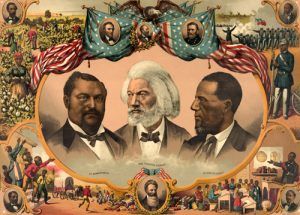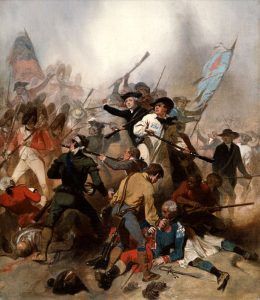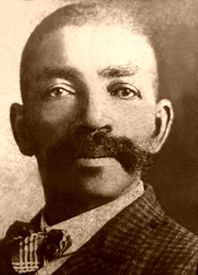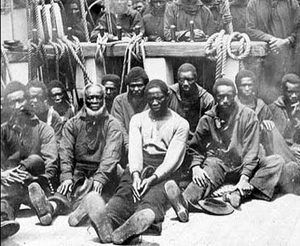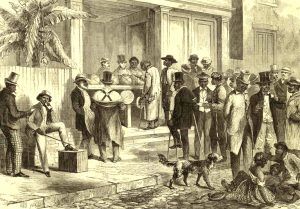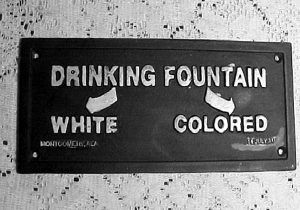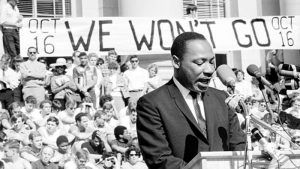Historic African Americans:
Ida Wells Barnett – Founder of the NAACP
James Beckwourth – Explorer and Mountain Man
Black Seminole Scouts – Protecting the Texas Frontier
Benjamin Brown – Honorable Buffalo Soldier
Buffalo Soldiers of the American West
Rufus Cannon – Important Marshal
George Washington Carver – Scientist, Educator, Inventor
Mary Ann Shadd Cary – Activist, Teacher, & Writer
Cherokee Bill – Terror of Indian Territory
Frederick Douglass – From Slavery to Renowned Activist
Mary Fields – Female Stage Driver
Samuel Fields – Shakespearian Orator of Deadwood
Junius George Groves – Potato King of the World
Professor Ernest Hawkins – Teaching in Fort Scott
Bose Ikard – Black Cowboy in Texas
Martin Luther King Jr. – Civil Rights Activist & Hero
Nat Love, aka Deadwood Dick – Great Cowboy
Lucretia “Aunt Lou” Marchbanks – Greatest Cook in the Black Hills
Bridget “Biddy” Mason – African American Entrepreneur
Isaiah Mays – Honorable Buffalo Soldier
Edward P. McCabe – Nicodemus colonizer & State Auditor
George McJunkin – Black Cowboy & History Changing Amateur Archaeologist
George “Alfred” Monroe – Slave to Skilled “Whip”
William “Bill” Pickett – Texas Bull-Dogger
Salem Poor – From Slave to Hero
Benjamin “Pap” Singleton – Leading the Exodusters
Harriet Tubman – Moses of the Underground Railroad
Articles:
African Americans in the Revolutionary Period
African American Photo Gallery
African Americans – From Slavery to Equality
Chattel Hood to Freedom – Black Pioneers Help Settle California
The Crucial Role of the Negro Motorist Green Book
Kansas Freedmen’s Relief Association
Nicodemus, Kansas – A Black Pioneer Town
Slavery – Cause and Catalyst of the Civil War
Slavery & Emancipation Photo Gallery
Slavery Terms and Reference Items
Riding on the Underground Railroad
We hold these truths to be self-evident that all men are created equal, that they are endowed by their Creator with certain unalienable Rights, that among these are Life, Liberty, and the Pursuit of Happiness.
— Declaration of Independence
One of the largest ethnic groups in the United States, African Americans are primarily the descendants of slaves.
Today, most African Americans are descended from various ethnic groups, mostly from western and central Africa. They were captured in African wars or raids and transported in the Atlantic slave trade. Though they came with varied customs, religious beliefs, and language, European standards and ideals were forced upon them once they arrived in America.
The first Africans in the New World arrived with Spanish and Portuguese explorers and settlers and assisted in the early exploration of the Americas. In 1581, the Spanish in St. Augustine, Florida, imported the first enslaved Africans into what would become the United States. In 1619, 20 African captives were sold to settlers at Point Comfort, today’s Fort Monroe, in Hampton, Virginia, 30 miles downstream from Jamestown, Virginia. After several years, the colonists treated these captives as indentured servants and released them. However, this practice was gradually replaced by the system of race-based slavery used in the Caribbean. Soon, more African captives were brought to America in increasing numbers to fill the desire for labor in a country where land was plentiful and labor was scarce.
Massachusetts was the first colony to legalize slavery in 1641. Attempts to hold black servants beyond the typical term of indenture culminated in the legal establishment of black chattel slavery in Virginia in 1661 and all the English colonies by 1750. Other colonies followed suit by passing laws that passed slavery on to the children of slaves and making non-Christian imported servants slaves for life. This principle prevailed in the English colonies even though they would later win their independence and articulated national ideals in direct opposition to slavery.
However, some blacks gained freedom, property, and access to American society during this time. Many moved to the North, where slavery, although still legal, was less of a presence. By 1790, slaves and free blacks numbered almost 760,000 and made up nearly one-fifth of the population of the United States.
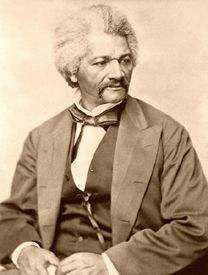
Frederick Douglass was born into slavery and escaped to spend his life fighting for justice and equality for all people.
By the early 1800s, many whites and free blacks in Northern states began to call for the abolition of slavery. Frederick Douglass, a young black slave taught to read by his master’s wife in Baltimore, Maryland, escaped to Massachusetts in 1838. He became an influential writer, editor, and lecturer for the growing abolitionist movement. By 1840, abolitionists in Britain and the United States developed large, complex propaganda campaigns against slavery. As the nation split between Southern slave and Northern free states before the Civil War, the Underground Railroad spirited thousands of escaped slaves from the South to the North.
When the Civil War began, many Northern free blacks and runaway slaves from the South volunteered to fight for the Union, hoping to liberate their people across the nation. President Abraham Lincoln’s Emancipation Proclamation on January 1, 1863, changed the status of three million African Americans in the South from “slave” to “free.” This drastically increased the number of runaway slaves, many joining the Union forces. By the time the war ended in 1865, about 200,000 black men had served as soldiers in the U.S. Army and Navy. Forty thousand black soldiers died in the war: 10,000 in battle and 30,000 from illness or infection.
After the Union’s victory over the Confederacy, the Civil Rights Act of 1866 made African Americans full U.S. citizens, and Reconstruction began to bring the South back into the Union. Over the next five years, the 11 states of the Confederacy were readmitted into the Union and made some strides toward equal rights for African Americans. Blacks established their own churches, schools, towns, and businesses during these years. Tens of thousands migrated to Mississippi to clear and own their land, as 90% of the bottomlands were undeveloped. The 15th Amendment, ratified in 1870, extended the right to vote to black males, and soon, African Americans were elected to Congress and other public offices.
But, all was not well, as many Southerners soon reacted to black emancipation. When Northern troops left in 1877, the white power structure returned, and the Ku Klux Klan organized terrorist raids, lynchings, and burned homes, schools, and churches. Within a few decades, this power structure successfully suppressed blacks who were excluded from voting by intimidation and lived under constant threat of violence. Southern states wrote Jim Crow laws that segregated blacks from white society.
Beginning in the 1890s, many African Americans started moving North. This migration pattern became more pronounced as some six million blacks moved from rural areas of the South to northern and western cities between 1916 and 1970 during the Great Migration. During this time, World War I opened many factory jobs. In the 1920s, strict new laws drastically cut European immigration, which created a demand for industrial workers in the Northern cities. Still suppressed by segregation, more Southern blacks continued to migrate northward in increasing numbers, eagerly taking unskilled jobs in meatpacking plants, steel mills, and auto assembly lines in Chicago, Omaha, and Detroit.
The American Civil Rights Movement began in the 1950s using nonviolence and passive resistance to change discriminatory laws and practices, primarily in the South. The movement awakened the country’s conscience to the plight of African Americans, who had long been denied first-class citizenship. As a result, increases in median income and college enrollment among the black population were dramatic in the late 20th century, which led to broader access to professional and business opportunities and significant political victories.

